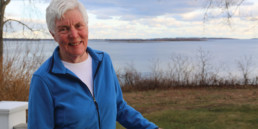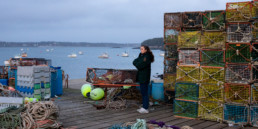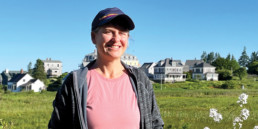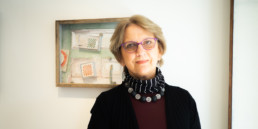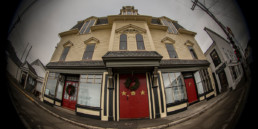Louis Wellington Cabot—An Example for the Ages
Warmth, wisdom, and gentle touch kept the Island Institute on track
By Philip Conkling
Louis Cabot died at home in Tenants Harbor this past January, a half-year short of his 100th birthday. It was my great good fortune to have known and worked with Louis for the last quarter century of his life.
Although Louis—pronounced “Louie,” not “Lewis”—served on the board of the Island Institute for almost two decades and chaired the Island Institute’s successful $20 million capital campaign, the indelible memories I cherish of him are connected to watching his warm-hearted humor and humanity disarm everyone he encountered—whether he was speaking with an entitled member of the New York Yacht Club or a crusty islander. He was always a sip of cool water in a hot moment.
Louis was the oldest son of Tom Cabot, the legendary Boston industrialist and great Maine yachtsman who owned—and gave away—more islands than any other human. Although Louis grew up sailing with his father along the Maine coast aboard his father’s yacht, Avelinda, Louis seemed to steer clear of Maine for much of his adulthood—as if this gunk-holey coast might be a hard place for a son to follow in his father’s wide wake.
I first encountered the Cabot father and son together one long lingering evening on Swan’s Island. Peter Ralston and I had brought Fish Hawk out from Rockland to watch the first load of Atlantic salmon fingerlings sluiced from big tanks aboard the Swan’s Island ferry into net pens off the southern shore of Swan’s. We asked Tom Cabot, who had made a small investment in the island aquaculture venture, if he wanted to come watch. When we rounded into Garden Cove to pick Tom up, there at the dock was Louis aboard his own vessel, the beautiful blue Yonder. When the four of us returned at the end of the successful salmon spectacle, Louis invited us below for a cup of his famous cruising brew, the Avelinda special—vodka and Tang.
As the nautical libation warmed the atmosphere below, Tom held forth on the importance of fish—especially the humble cod—to the Cabot family. A cod has a prominent place on the family shield, he said, an emblem of its importance ever since John Cabot first discovered the great fishing grounds off the coast of Newfoundland in the 15th century. As he further warmed to his subject, Tom declaimed that the Cabot family could be traced “all the way back to Charlemagne.”
“Well, Pa,” Louis said gently, “maybe not quite back to Charlemagne.”
Louis Cabot had lots of experience with great and important people and boards—whether as chairman of the Federal Reserve Bank of Boston, chairman of the Board of the Brookings Institution, and the Board of Overseers of Harvard University. At the Island Institute, Louis would often crystalize an issue by asking a probing question, not by presenting an answer. No important decision was ever finalized until Louis spoke, because his warmth and humor could always cut through confusion and controversy.
I wondered how Louis had developed such a deft touch in such circumstances and got an insight into how that skill might have developed. The Cabot family managed many properties jointly, including a beloved ranch in southern Colorado. Louis, as the eldest of five children of Tom and Virginia, had four outspoken siblings and a veritable small Congress of nieces and nephews, not to mention his own children, to consult on important family decisions. None of these individuals are shrinking violets.
A board of seven was created to make important decisions and Louis insisted that they operate by consensus. But if that were not possible, he suggested that decisions be reached by consensus minus two—so that no one person could upend a decision, but if two were opposed, the issue would be revisited.
I have no idea how that worked in practice, but it is my enduring impression of Louis’ Solomon-like wisdom.
In his last few years, after Louis had “swallowed the anchor,” as he put it, I would see him on his narrow porch overlooking the vessels great and small in the Tenants Harbor anchorage, with his beloved wife, Muffie, steadfastly at his side. He was always eager to see who was coming into or going out of the harbor, imagining their adventures beginning or ending and observing the cut of their jib.
Louis Cabot was an example for the ages and ended his days at peace.
Philip Conkling is the founder of the Island Institute and author of Islands in Time. He now operates Conkling & Associates.

